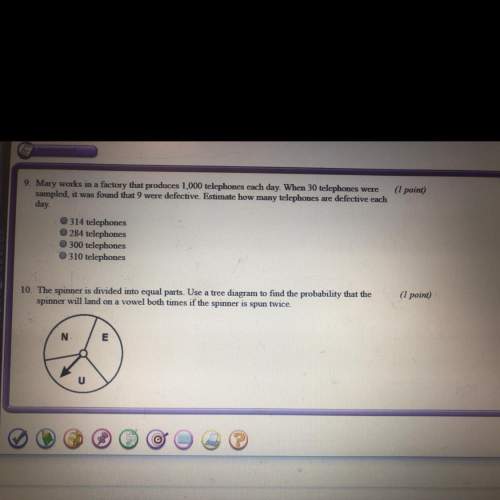C=
5
9
(F−32)
The equation above shows how temperature F, measured in degre...

Mathematics, 11.01.2021 04:00 taylorreneeax9227
C=
5
9
(F−32)
The equation above shows how temperature F, measured in degrees Fahrenheit, relates to a temperature C, measured in degrees Celsius. Based on the equation, which of the following must be true?
A temperature increase of 1 degree Fahrenheit is equivalent to a temperature increase of
5
9
degree Celsius.
A temperature increase of 1 degree Celsius is equivalent to a temperature increase of 1.8 degrees Fahrenheit.
A temperature increase of
5
9
degree Fahrenheit is equivalent to a temperature increase of 1 degree Celsius.
A) I only
B) II only
C) III only
D) I and II only
ANSWER EXPLANATION: Think of the equation as an equation for a line
y=mx+b
where in this case
C=
5
9
(F−32)
or
C=
5
9
F−
5
9
(32)
You can see the slope of the graph is
5
9
, which means that for an increase of 1 degree Fahrenheit, the increase is
5
9
of 1 degree Celsius.
C=
5
9
(F)
C=
5
9
(1)=
5
9
Therefore, statement I is true. This is the equivalent to saying that an increase of 1 degree Celsius is equal to an increase of
9
5
degrees Fahrenheit.
C=
5
9
(F)
1=
5
9
(F)
(F)=
9
5
Since
9
5
= 1.8, statement II is true.
The only answer that has both statement I and statement II as true is D, but if you have time and want to be absolutely thorough, you can also check to see if statement III (an increase of
5
9
degree Fahrenheit is equal to a temperature increase of 1 degree Celsius) is true:
C=
5
9
(F)
C=
5
9
(
5
9
)
C=
25
81
(whichis≠1)
An increase of
5
9
degree Fahrenheit leads to an increase of
25
81
, not 1 degree, Celsius, and so Statement III is not true.

Answers: 2
Another question on Mathematics

Mathematics, 21.06.2019 16:30
Sam claims that cos x =sin y if x and y are congruent angels. is sam correct ?
Answers: 2

Mathematics, 21.06.2019 18:00
Kayla has a $500 budget for the school party.she paid $150 for the decorations.food will cost $5.50 per student. what inequality represents the number of students,s, that can attend the party?
Answers: 1

Mathematics, 21.06.2019 21:30
In δabc shown below, ∠bac is congruent to ∠bca: triangle abc, where angles a and c are congruent given: base ∠bac and ∠acb are congruent. prove: δabc is an isosceles triangle. when completed (fill in the blanks), the following paragraph proves that line segment ab is congruent to line segment bc making δabc an isosceles triangle. (4 points) construct a perpendicular bisector from point b to line segment ac . label the point of intersection between this perpendicular bisector and line segment ac as point d: m∠bda and m∠bdc is 90° by the definition of a perpendicular bisector. ∠bda is congruent to ∠bdc by the definition of congruent angles. line segment ad is congruent to line segment dc by by the definition of a perpendicular bisector. δbad is congruent to δbcd by the line segment ab is congruent to line segment bc because consequently, δabc is isosceles by definition of an isosceles triangle. 1. corresponding parts of congruent triangles are congruent (cpctc) 2. the definition of a perpendicular bisector 1. the definition of a perpendicular bisector 2. the definition of congruent angles 1. the definition of congruent angles 2. the definition of a perpendicular bisector 1. angle-side-angle (asa) postulate 2. corresponding parts of congruent triangles are congruent (cpctc)
Answers: 1

Mathematics, 22.06.2019 00:50
Problem 2. find the exact value of the remaining trigonometric functions. sketch theangle 8 for each problem. (3 points each)(a) tan 0 =o is in quadrant 2
Answers: 2
You know the right answer?
Questions

History, 24.02.2021 01:00



Mathematics, 24.02.2021 01:00




History, 24.02.2021 01:00

Chemistry, 24.02.2021 01:00

Spanish, 24.02.2021 01:00

Social Studies, 24.02.2021 01:00

Mathematics, 24.02.2021 01:00

Chemistry, 24.02.2021 01:00


Mathematics, 24.02.2021 01:00

Mathematics, 24.02.2021 01:00

Mathematics, 24.02.2021 01:00

Mathematics, 24.02.2021 01:00

English, 24.02.2021 01:00

Computers and Technology, 24.02.2021 01:00




